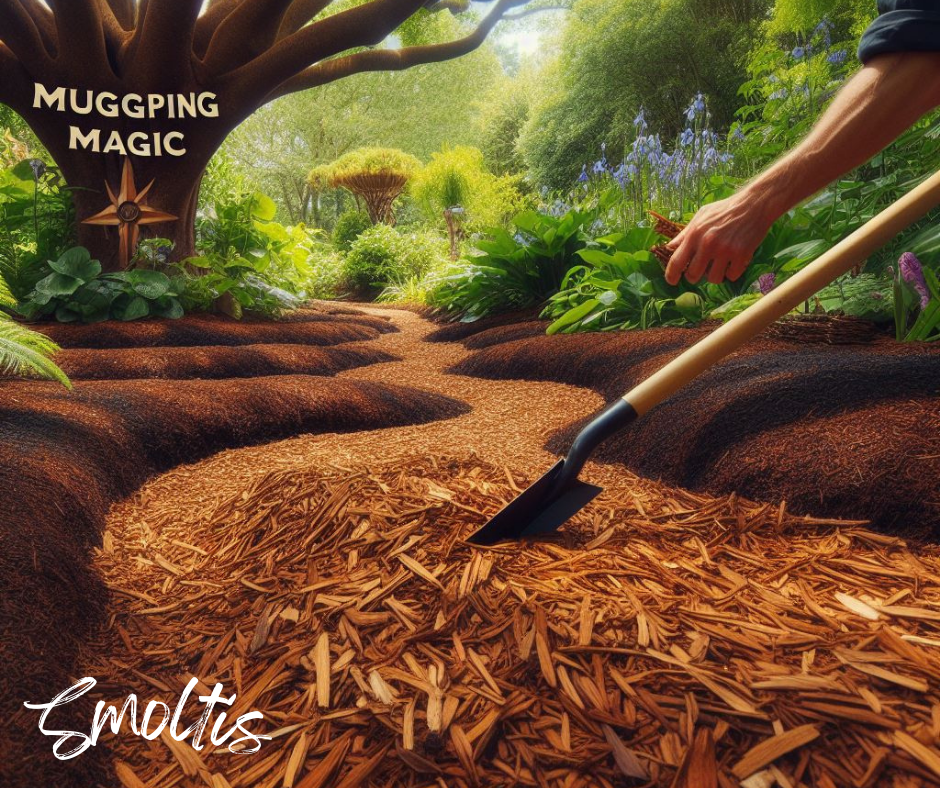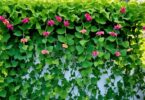Gardening in shaded areas can present unique challenges, particularly when it comes to maintaining soil moisture. However, the strategic use of mulch can be a game-changer, helping to conserve precious water and create a thriving, low-maintenance garden. This article will explore the benefits of mulching in shaded areas, provide guidance on choosing the right mulch, and offer tips on proper application and maintenance techniques.

Key Takeaways
- Mulching in shaded areas helps retain soil moisture, regulate temperature, and suppress weed growth.
- Organic mulches, such as wood chips or leaf litter, are excellent options for shaded landscapes.
- Proper mulch application depth and coverage are crucial for maximizing the benefits in shade.
- Ongoing maintenance, like replenishing and preventing compaction, is essential for maintaining a thriving, low-maintenance garden.
- Integrating mulch with other landscape features can enhance the overall aesthetic of a shaded outdoor space.
The Benefits of Mulching in Shaded Areas
Mulching in shaded areas offers several key benefits. First, it helps to retain soil moisture by reducing evaporation, ensuring that plants have access to the water they need, even in drier conditions. Secondly, mulch acts as an insulating layer, regulating soil temperature and preventing extreme fluctuations that can stress plants. Additionally, a layer of mulch suppresses weed growth, reducing the need for manual weeding and creating a more low-maintenance garden environment.
Moisture Retention
The strategic use of mulch in shaded areas can greatly enhance moisture retention in the soil. By forming a protective barrier over the ground, mulch reduces the rate of evaporation, allowing plants to have consistent access to the moisture they require, even during periods of drought or limited rainfall.
Temperature Regulation
Mulch also plays a crucial role in temperature regulation within shaded landscapes. The insulating properties of the mulch layer help to moderate soil temperatures, preventing extreme fluctuations that can be detrimental to plant health. This temperature regulation helps to create a more stable and hospitable environment for shade-loving plants to thrive.
Weed Suppression
The presence of a mulch layer in shaded areas effectively suppresses weed growth. By blocking sunlight and creating a physical barrier, mulch inhibits the germination and establishment of unwanted weeds. This, in turn, reduces the need for manual weeding, resulting in a low-maintenance garden that requires fewer time-consuming upkeep tasks.
Choosing the Right Mulch for Shade
When it comes to mulching in shaded areas, the choice of mulch material is crucial. Organic mulches, such as wood chips, shredded bark, or leaf litter, are excellent options as they break down over time, improving soil structure and fertility. These organic mulches not only help retain moisture but also regulate temperature in the shaded landscape.
Organic Mulches
Organic mulches, like wood chips or shredded bark, offer a range of benefits for gardening in shaded areas. As they decompose, they enrich the soil with vital nutrients, enhancing the overall health and fertility of the planting beds. Additionally, organic mulches have a natural ability to retain moisture, ensuring that plants in the shade have access to the water they need, even during drier periods.
Inorganic Mulches
While inorganic mulches, such as gravel or rubber, can also be effective in shaded areas, they do not offer the same soil-enhancing benefits as their organic counterparts. These inorganic options can still provide temperature regulation and moisture retention capabilities, making them a viable choice for certain shaded landscape designs. However, gardeners should carefully consider the overall aesthetic and environmental impact when selecting inorganic mulches for their shaded gardens.
Shade-Tolerant Plants and Mulching
Pairing the right mulch with shade-tolerant plants is key to creating a thriving garden in shaded areas. Some plants, such as ferns, hostas, and hydrangeas, are naturally adapted to growing in low-light conditions and benefit greatly from the moisture-conserving properties of mulch. By selecting shade-tolerant plants that can thrive in the shade and applying a suitable mulch, gardeners can establish a low-maintenance, lush landscape that requires minimal watering and weeding.
When it comes to shade-tolerant plants, there are several options that pair perfectly with mulching in shaded areas. Ferns, with their delicate, feathery fronds, add a touch of elegance and texture to the shaded garden, while moisture-loving hostas offer a range of bold, vibrant foliage colors. Hydrangeas, with their large, showy blooms, thrive in shaded conditions and respond well to the moisture conservation provided by mulch.
By selecting a diverse array of shade-tolerant plants and applying a suitable mulch, gardeners can create a lush, low-maintenance oasis in their shaded outdoor spaces. This synergistic approach not only enhances the aesthetic appeal of the garden but also minimizes the need for frequent watering and weeding, making it an ideal solution for busy homeowners or those seeking a more sustainable, moisture-conserving landscape.
Preparing the Area for Mulching
Before applying mulch in a shaded area, it’s crucial to properly prepare the site. This preparatory step lays the foundation for a thriving, low-maintenance garden. The process involves two key elements: clearing debris and amending the soil.
Clearing Debris
The first step in preparing the area for mulching is to clear away any existing debris, such as fallen leaves, twigs, or other organic matter. This ensures that the mulch can make direct contact with the soil, maximizing its benefits for moisture conservation and soil health. By removing these materials, you create a clean canvas for the mulch to be applied effectively.
Soil Amendments
In addition to clearing debris, incorporating soil amendments can further enhance the benefits of mulching in shaded areas. Adding compost or other organic matter to the soil can improve its structure and fertility, providing a more nurturing environment for your plants to thrive. These amendments help to regulate soil moisture and temperature, complementing the moisture-conserving properties of the mulch.
By addressing both debris clearing and soil amendments, you set the stage for a successful mulching application in your shaded landscape. This preparatory work ensures that the mulch can effectively perform its role in maintaining optimal soil conditions and promoting the growth of your shade-tolerant plants.
Proper Mulching Techniques for Shaded Areas
Applying mulch in shaded areas requires careful attention to specific techniques to ensure optimal results. When applying the mulch, it’s crucial to spread it evenly, avoiding the creation of thick, uneven layers that can lead to problematic issues such as water runoff or mold growth.
Applying the Mulch
The key to proper mulch application in shaded areas is ensuring an even distribution. Gardeners should take the time to carefully spread the mulch, creating a consistent layer that covers the soil surface. This not only enhances the visual appeal of the space but also maximizes the benefits of mulching, such as moisture retention and weed suppression.
Depth and Coverage
The ideal depth for mulch in shaded areas is typically 2-4 inches. This depth provides sufficient insulation and moisture retention without smothering the plants. Proper coverage is also crucial, with the mulch extending slightly beyond the drip line of the plants. This ensures that the entire root zone is protected and that the moisture-conserving benefits of the mulch are fully realized throughout the shaded landscape.
Maintaining Mulch in Shade
Maintaining the mulch in shaded areas is an ongoing process. As the mulch decomposes over time, it will need to be replenished to maintain the desired depth and coverage. Additionally, the reduced sunlight in shaded areas can lead to increased compaction, which can impede water and air circulation in the soil. Regularly loosening the mulch and adding new material as needed can help prevent this issue and ensure the continued benefits of mulching in the shade.
Replenishing Mulch
Over time, the mulch in shaded areas will naturally break down, reducing its depth and effectiveness. It’s important to regularly replenish the mulch, typically once or twice a year, to maintain the optimal 2-4 inch layer. This not only preserves the moisture-retaining and weed-suppressing properties of the mulch but also ensures a consistent, aesthetically pleasing appearance throughout the shaded landscape.
Preventing Compaction
The reduced sunlight in shaded areas can lead to increased compaction of the mulch, which can impede the flow of water and air to the soil and plant roots. To prevent this issue, it’s important to regularly loosen the mulch, either by gently raking or using a garden fork. This process helps to aerate the soil, improve drainage, and maintain the overall health of the plants in the shaded garden.
| Mulch Maintenance in Shade | Recommended Practices |
|---|---|
| Replenishment | Replenish mulch 1-2 times per year to maintain 2-4 inch depth |
| Compaction Prevention | Regularly loosen mulch to aerate soil and improve drainage |
Shade
Shade is a term used to describe the area where direct sunlight is blocked, creating a cooler and more sheltered environment. Shade can be created by various natural and artificial structures, such as trees, buildings, awnings, or umbrellas. The degree of shade can vary, from partial or dappled shade to complete shade, and it can have a significant impact on the growth and health of plants in a garden or landscape.
Shade can provide a welcomed respite from the sun’s harsh rays, offering a tint or hue of cover for outdoor spaces. This shadow cast by canopies and other structures can create a soothing and inviting atmosphere, perfect for relaxation or entertaining. Gardeners and landscape designers must carefully consider the shade patterns in their outdoor areas, as this can greatly influence the selection and placement of plants, as well as the overall ambiance of the space.
Integrating Mulch into Your Shaded Landscape Design
Beyond the practical benefits of mulching in shaded areas, incorporating this versatile material into your landscape design can contribute to the overall aesthetic of the space. By thoughtfully combining mulch with other features, such as pathways, seating areas, or water elements, gardeners can create a cohesive and visually appealing shaded oasis that seamlessly blends function and form.
Combining Mulch with Other Features
Mulch can be used to enhance the visual appeal of various landscape elements in shaded areas. For example, lining pathways with a contrasting color or texture of mulch can create a natural, inviting walkway that guides visitors through the shade. Surrounding seating areas with a soft, cushioning layer of mulch can provide a comfortable and visually harmonious setting for relaxation. Integrating mulch around water features, such as fountains or ponds, can further accentuate the tranquil, nature-inspired ambiance of the shaded landscape.
Aesthetic Considerations
When incorporating mulch into a shaded landscape design, the aesthetic qualities of the material should be carefully considered. The color and texture of the mulch can have a significant impact on the overall look and feel of the space. For instance, darker-colored mulches, such as those derived from hardwood bark, can create a rich, earthy tone that complements the shaded environment, while lighter-colored mulches, like pine needles or gravel, can add a refreshing, airy contrast. Additionally, the texture of the mulch, whether it is fine and smooth or coarse and chunky, can contribute to the tactile and visual interest of the shaded landscape.
By thoughtfully integrating mulch with other landscape features and considering its aesthetic properties, gardeners can transform their shaded areas into visually stunning and cohesive outdoor havens that seamlessly blend functionality and beauty.
Conclusion
Mulching in shaded areas has proven to be a highly effective way to conserve moisture, regulate soil temperature, and suppress weed growth, ultimately creating a thriving, low-maintenance garden. By understanding the numerous benefits of mulching, gardeners can select the right materials and implement proper application and maintenance techniques to transform their shaded spaces into lush, vibrant outdoor havens.
Integrating mulch into a comprehensive landscape design can also contribute to the overall aesthetic and enjoyment of these shaded areas. The strategic use of mulch, combined with thoughtful plant selection and other design elements, can result in a harmonious and visually appealing outdoor environment that requires minimal upkeep.
As gardeners continue to explore the power of mulching in shaded areas, they can unlock the true potential of these spaces, creating oases of tranquility and natural beauty that require less time and effort to maintain. By embracing the principles of moisture conservation and low-maintenance gardening, homeowners and landscape enthusiasts can craft their dream shaded retreats, where the soothing effects of shade and the nurturing benefits of mulch come together in perfect harmony.
FAQ
What are the benefits of mulching in shaded areas?
Mulching in shaded areas offers several key benefits, including moisture retention, temperature regulation, and weed suppression. The insulating layer of mulch helps retain soil moisture by reducing evaporation, ensuring plants have access to the water they need, even in drier conditions. Mulch also regulates soil temperature, preventing extreme fluctuations that can stress plants. Additionally, a layer of mulch suppresses weed growth, reducing the need for manual weeding and creating a more low-maintenance garden environment.
What types of mulch are best for shaded areas?
When it comes to mulching in shaded areas, both organic and inorganic mulches can be effective. Organic mulches, such as wood chips, shredded bark, or leaf litter, are excellent options as they break down over time, improving soil structure and fertility. Inorganic mulches, like gravel or rubber, can also be effective, but they do not offer the same soil-enhancing benefits as organic materials. When selecting a mulch, consider factors like moisture retention, temperature regulation, and the overall aesthetic you are trying to achieve in your shaded landscape.
How should I prepare the area before applying mulch in shaded areas?
Before applying mulch in a shaded area, it’s important to properly prepare the site. This includes clearing away any existing debris, such as fallen leaves, twigs, or other organic matter, to ensure the mulch can make direct contact with the soil. Additionally, incorporating soil amendments, such as compost or organic matter, can improve soil structure and fertility, further enhancing the benefits of mulching.
What is the proper way to apply mulch in shaded areas?
Applying mulch in shaded areas requires specific techniques to ensure optimal results. When applying the mulch, it’s important to spread it evenly, avoiding thick, uneven layers that can lead to issues like water runoff or mold growth. The ideal depth for mulch in shaded areas is typically 2-4 inches, providing sufficient insulation and moisture retention without smothering the plants. Proper coverage, ensuring the mulch extends slightly beyond the drip line of the plants, is also crucial for maximizing the benefits of mulching in shaded landscapes.
How should I maintain the mulch in my shaded garden?
Maintaining the mulch in shaded areas is an ongoing process. As the mulch decomposes over time, it will need to be replenished to maintain the desired depth and coverage. Additionally, the reduced sunlight in shaded areas can lead to increased compaction, which can impede water and air circulation in the soil. Regularly loosening the mulch and adding new material as needed can help prevent this issue and ensure the continued benefits of mulching in the shade.







